Discover The Enchanting Secrets Of Trimbakeshwar Temple In 2026
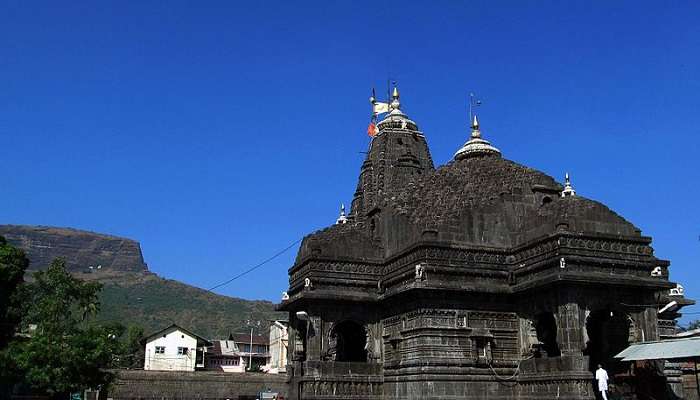
Nestled in the ancient town of Trimbak, near the bustling city of Nashik in Maharashtra, lies the revered Trimbakeshwar Temple. This sacred site holds immense significance for Hindus as one of the twelve Jyotirlingas, the holiest abodes of Lord Shiva. Steeped in mythology and history, the Trimbakeshwar Temple beckons pilgrims and travellers alike to experience its spiritual aura and architectural grandeur. Beyond its religious importance, the temple also holds a unique geographical distinction. It stands at the origin of the Godavari River, the second-longest river in India, making it a pilgrimage site for both spiritual seekers and nature enthusiasts. The temple’s serene surroundings and rich cultural heritage create an unforgettable experience for all who visit.
Unravelling The Legend Of Trimbakeshwar
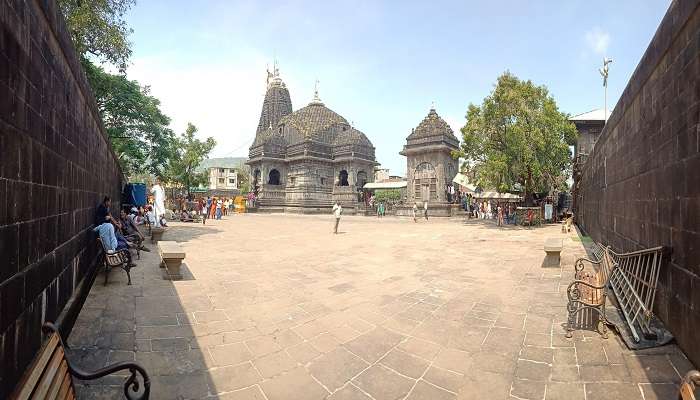
The Trimbakeshwar Temple is shrouded in ancient legends and myths. According to Hindu mythology, the temple marks the spot where Lord Shiva manifested himself as the Trimbakeshwar Jyotirlinga, a radiant column of light representing the divine energy of the universe. The temple’s name, Trimbakeshwar, derives from the Sanskrit words “Tri” meaning three, “Ambaka” meaning eye, and “Ishwar” meaning God, referring to the three-eyed form of Lord Shiva.
Legend also has it that the Godavari River originated from the matted locks of Lord Shiva, flowing through the Brahmagiri Hills and nourishing the land below. The temple’s association with the Godavari River adds another layer of sanctity to this already revered site.
Also Read: Trekking Near Nashik
Architectural Marvel: A Testament To Hemadpanthi Craftsmanship
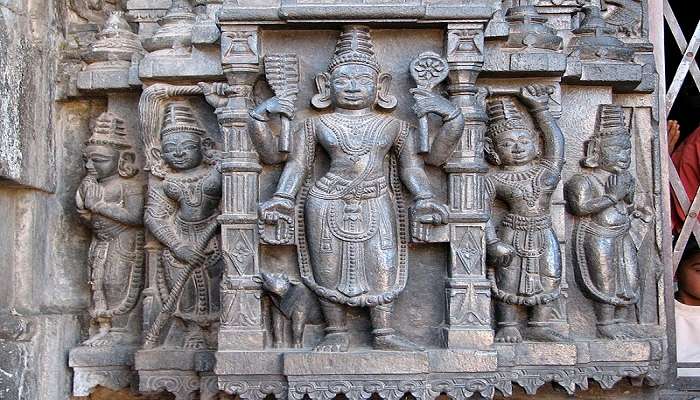
The Trimbakeshwar Temple showcases the exquisite Hemadpanti architectural style, characterised by its black stone construction, intricate carvings, and ornate pillars. The temple’s central shrine houses the sacred Jyotirlinga, a cylindrical black stone representing Lord Shiva. The linga is adorned with a jewelled crown that is believed to be from the age of the Pandavas, adding to the temple’s mystique.
The temple complex also includes several smaller shrines dedicated to various deities, including Lord Ganesha, Goddess Parvati, and Lord Vishnu. The intricate carvings on the temple walls depict scenes from Hindu mythology, providing a glimpse into the region’s rich cultural heritage.
Pilgrimage And Rituals
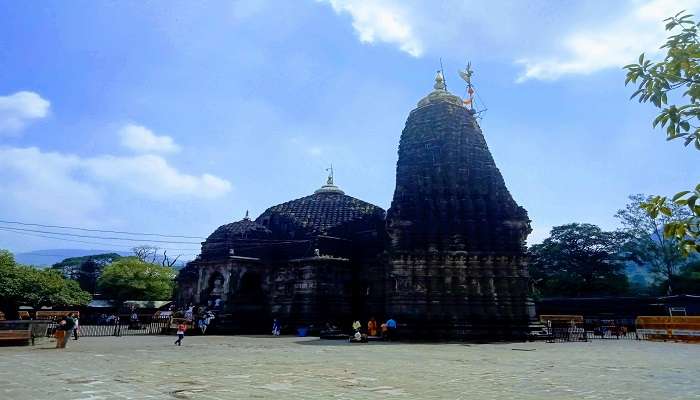
The Trimbakeshwar Temple attracts thousands of devotees who come to seek blessings and participate in various rituals yearly. The temple is renowned for its Kumbh Mela, a massive religious gathering every twelve years. During the Kumbh Mela, millions of pilgrims gather to bathe in the sacred Kushavarta Kund, a holy pond believed to purify the soul.
Other important rituals performed at the temple include the Narayan Nagbali Puja, a ritual to appease ancestral spirits, and the Kaal Sarp Yog Puja, a ritual to ward off negative planetary influences. The temple’s priests conduct these rituals with utmost devotion, creating a deeply spiritual atmosphere for the devotees.
Related Read: Mumbai to Nashik Road Trip
Trimbakeshwar In 2026
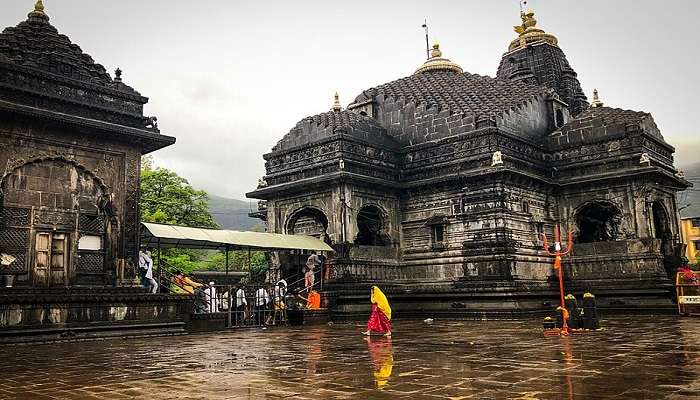
The Trimbakeshwar Temple continues to be a beacon of faith and spirituality. The temple authorities have taken several initiatives to enhance the visitor experience, including improved facilities for pilgrims, upgraded security measures, and a more streamlined darshan (viewing) process.
Whether you’re a devout Hindu seeking spiritual solace or a traveller curious about India’s rich cultural heritage, the Trimbakeshwar Temple promises an enriching experience. Its timeless charm and unique blend of religious and natural significance make it a must-visit destination for anyone exploring the Nashik region.
Plan Your Visit: A Journey To Remember
Trimbakeshwar is well-connected by road and rail, making it easily accessible from major cities in Maharashtra. The temple is open for darshan throughout the year, with special rituals and ceremonies held during festivals like Mahashivratri and Kumbh Mela.When planning your visit, dress modestly and respect the temple’s sanctity. Photography is prohibited inside the main shrine, but you can capture the temple’s exterior beauty and the serene surroundings.
1. A Photographer’s Delight
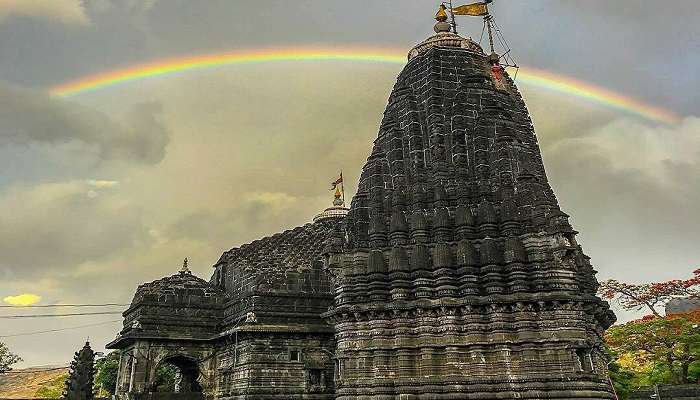
The Trimbakeshwar Temple and its surroundings offer ample opportunities for photography enthusiasts. The temple’s architectural details, the vibrant rituals, and the serene landscapes provide a rich tapestry of subjects to capture. The early morning light is particularly magical, casting a golden glow on the temple and the surrounding hills.
Remember to respect the temple’s sanctity and avoid photographing inside the main shrine. However, the temple’s exterior, the Kushavarta Kund, and the surrounding landscapes offer plenty of opportunities for capturing stunning images.
Related Read: Picnic Spots In Nashik
2. A Foodie’s Paradise
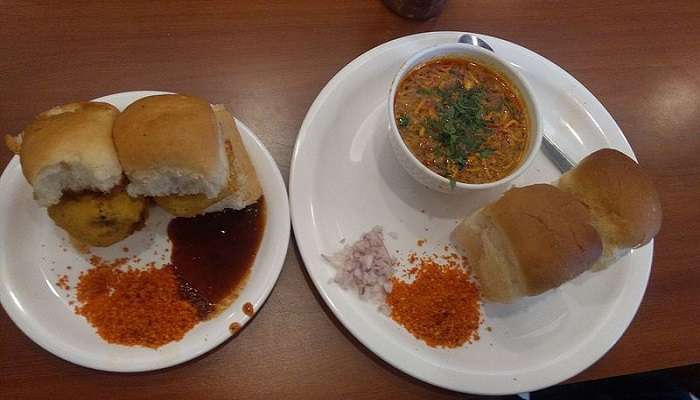
No trip to Trimbakeshwar is complete without sampling the local cuisine. The town is known for its Maharashtrian delicacies, including spicy curries, flavorful rice dishes, and sweet treats like modak and puran poli. Several restaurants and eateries near the temple offer various options to satisfy every palate.
For a truly authentic experience, try the local street food, which includes favourites like vada pav, misal pav, and sabudana khichdi. The bustling markets near the temple are great places to find these local snacks, fresh fruits, vegetables, and other regional specialities.
3. A Hub for Spiritual Seekers
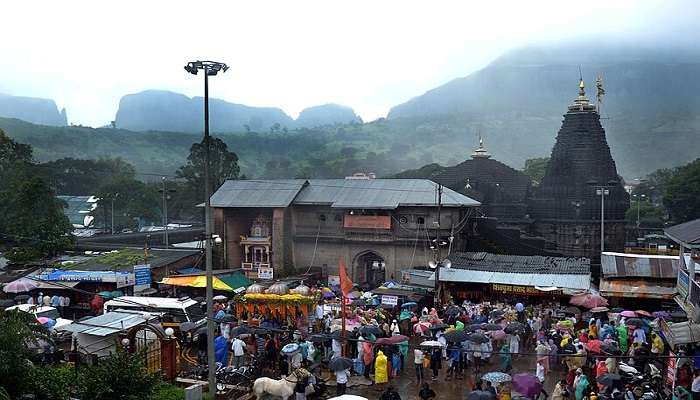
Trimbakeshwar is not just a religious site; it’s a hub for spiritual seekers from all walks of life. The town is home to several ashrams and meditation centres, offering a range of courses and retreats for those seeking inner peace and self-discovery. Whether you’re looking to deepen your spiritual practice or escape the hustle and bustle of city life.
Trimbakeshwar provides a tranquil environment for introspection and rejuvenation. The serene surroundings, the temple priests’ rhythmic chants, and the Godavari River’s gentle flow all contribute to a sense of peace and tranquillity.
You May Also Like To Read: Places To Visit In Nashik
Visiting Trimbakeshwar is more than just a trip; it’s a lifetime journey. It’s an opportunity to connect with your spiritual roots, immerse yourself in ancient traditions, and witness the beauty of India’s natural and cultural heritage. Whether you’re a devout pilgrim, a curious traveller, or a photography enthusiast, Trimbakeshwar has something to offer everyone. So pack your bags, plan your next trip to Nashik, and let Trimbakeshwar’s magic unfold before your eyes.
For our editorial codes of conduct and copyright disclaimer, please click here.
Cover Image Credit: Niraj Suryawanshi for Wikimedia Common
Frequently Asked Questions About Trimbakeshwar Temple
What is the best time to visit Trimbakeshwar Temple?
While the temple is open year-round, the best time to visit is during the cooler months, from October to March. The weather is pleasant, making exploring the temple complex and participating in rituals comfortable. Avoid visiting during monsoon season (June-September) as the region receives heavy rainfall.
Are there any specific rituals or offerings I should know about?
Trimbakeshwar Temple is famous for the Kaal Sarp Dosha Nivaran Puja a ritual believed to alleviate the astrological affliction of Kaal Sarp Dosha. Devotees also offer milk, bilva leaves, and flowers to Lord Shiva. It's advisable to consult with a temple priest for guidance on specific rituals and offerings.
Is there a dress code to enter the temple?
Yes, there is a modest dress code. Men are typically expected to wear dhotis or pants with a shirt, while women should wear sarees or salwar kameez. Avoid wearing revealing clothes or shorts.
How do I get to Trimbakeshwar Temple?
The temple is located near Nashik, Maharashtra. You can reach Nashik by air, train, or road. From Nashik, hire a taxi or take a bus to Trimbakeshwar, which is about 30 km away.
Are there any accommodation options near the temple?
Yes, several hotels, guesthouses, and dharamshalas are available near the temple to suit different budgets. It's advisable to book in advance, especially during peak season or festivals.
People Also Read:
Sri Venugopalaswamy Temple Omkareshwara Temple Baglamukhi Temple

With a passion for exploring and travelling to the roads long forgotten, experience the world through enthralling stories and adventures. Join me as I share my experiences at some of the world’s most popular tourist destinations and quench that pestering curiosity with something exciting!











